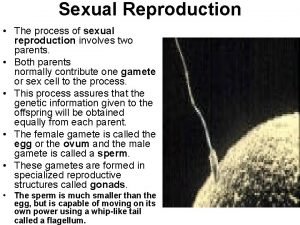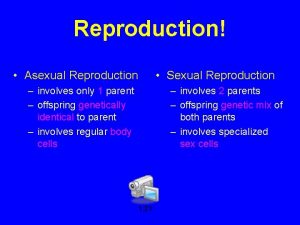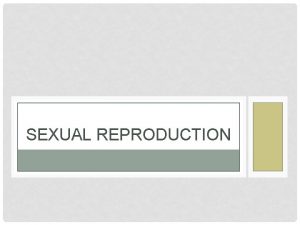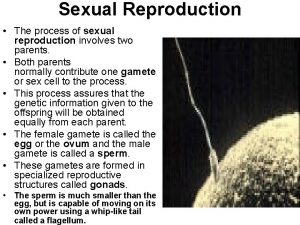11 4 SEXUAL REPRODUCTION Sexual reproduction involves the








- Slides: 8

11. 4 SEXUAL REPRODUCTION Sexual reproduction involves the development and fusion of haploid gametes.

■ In sexual reproduction, sex cells (gametes) fuse to form a zygote, which then grows into a new individual. ■ The gametes are produced in paired glands called gonads – males gametes (sperms) are formed in the testes. ■ The female gametes (ova or oocytes) are formed in the ovaries. ■ The process of gamete formation, known as gametogenesis, involves not only mitosis but also meiotic division, thereby halving the normal chromosomes numbers.

Gametogenesis ■ In gametogenesis, many gametes are produced, although relatively few of them are ever used in reproduction. ■ The process of gamete formation in testes and ovaries have a common sequence of phases. ■ 1 st: there is a multiplication phase in which the gamete mother cells divide by mitotic cell division. ■ 2 nd- each developing sex cell undergoes a growth phase. ■ 3 rd – comes the maturation phase. This involves meiosis and results in the formation of haploid gametes.



Testis: structure and function ■ Testes develop high on the posterior abdominal wall and migrate to the scrotum in about the seventh month of pregnancy. ■ The scrotum is about 3 degrees lower than the body, which is needed for sperm production. ■ Spermatogenesis begins in the testes at puberty and continues throughout life. ■ Each testis consists of many seminiferous tubules. ■ Tubules drain into a system of channels leading to the epididymis, which leads to the sperm duct.

Spermatogenesis ■ Spermatogenesis describes the production of spermatozoa (sperm) in the seminiferous tubules of the testes. ■ The process begins at puberty when the germline epithelium of the seminiferous tubules divides by mitosis. ■ These cells (spermatognia) then undergo a period of cell growth, becoming spermatocytes ■ The spermatocytes undergo two meiotic divisions to form four haploid daughter cells (spermatids) ■ The spermatids then undertake a process of differentiation in order to become functional sperm cells (spermatozoa)

Oogenesis ■ Oogenesis describes the production of female gametes (ova) within the ovaries ■ The process begins during fetal development, when a large number of primordial cells are formed by mitosis (about 40, 000) ■ These cells (oogonia) undergo cell growth until they are large enough to undergo meiosis ■ The primary oocytes begin meiosis but are arrested in prophase I when granulosa cells surround them to form follicles.














